How to cook perfect rice - in a frying pan
Rice is central to Japanese cuisine, so like most Japanese people, I have owned a rice cooker for as long as I can remember. Therefore, I usually cook rice in it. Sometimes I resort to another appliance, such as a pressure cooker for cooking brown rice. But truth be told I am not that good at making rice in a pot, mainly because I rarely have to do it. My rice cooker is always there for me. (My basic rice cooking method is here.)
But, recently I've been in several situations where I haven't had a rice cooker, but really needed to make some rice, either for eating or to make demo bentos during my book tour. That's when I decided to try making the rice in a frying pan. I'd seen this method on an NHK TV show called Necchuu Sutajiamu (Passion Stadium...yep I know, Japanese program show names can be a bit odd, especially in translation) back in October, and had been very intrigued at how easy it looked. I looked it up the program's website (Japanese page) as well as a how-to on Cookpad (also Japanese), the Japanese mega-cooking site, and gave it a try.
And you know what...it's so easy, and the results are really fantastic! I had perfectly cooked rice in less than 30 minute from measuring out to serving. Amazing!
I've tried commonly available methods of cooking rice before, such as adding rice to boiling water or vice versa, letting rice come to a boil in water in a pan and putting a lid on and letting it rest, and so on. None of those methods really worked to my satisfaction, especially for Japanese style rice -- you know, the kind that goes with Japanese meals, that gets turned into sushi rice, and so on. I am extremely picky about how my rice turns out. So this method was quite a revelation for me, in terms of how easy and foolproof it is.
I did have to make some small adjustments to the basic method to accommodate the quirks of an electric stovetop (as I explained in my my fried rice in a frying pain article, electric ranges are common in Europe, not so in Japan or the U.S., and I'm constantly adjusting my methods accordingly). Otherwise though, it's such a quick and easy method of making rice that I have been doing it this way quite often.
Recipe and method: Cooking Japanese-style rice in a frying pan
Note that the recipe/method here is for Japanese-style white rice. It should work with other white rice types too, but you may need to adjust the water amounts. Brown rice will need to be soaked in water for several hours if you're going to try cooking it in a frying pan. (I've seen brown rice that has been pre-treated to cook in the same amount of time as white rice in Japan and some Japanese grocery stores elsewhere, so you could try looking for that.)
You need:
- Japanese style medium-grain white rice (see Looking at different types of rice)
- A frying pan with a non-stick surface. I used a 28 cm / 11 inch diameter model. I recommend a similar size for making 1 to 2 cups of rice.
- A tight fitting lid for the frying pan. The lid does need to fit well so that excess steam gets trapped. A glass one is nice since it lets you see your rice's progress without opening the lid.
Following the method described in my basic rice how-to, rinse the rice and drain it well. (Rinsing does make a difference in taste! You just need to do it a few times.) Put the drained rice plus 1.1 times the amount of water by volume in the frying pan. So, if you have 1 cup of rice, use 1 cup and a bit of water. For 2 cups of rice, use 2.2 cups (about 2 and 1/4) water. I don't recommend doing more than 2 cups at a time in this size frying pan.
At this point, ideally you'll let the rice soak a bit (about half an hour) for plumper grains, but you can skip the soaking if you're in a big hurry.
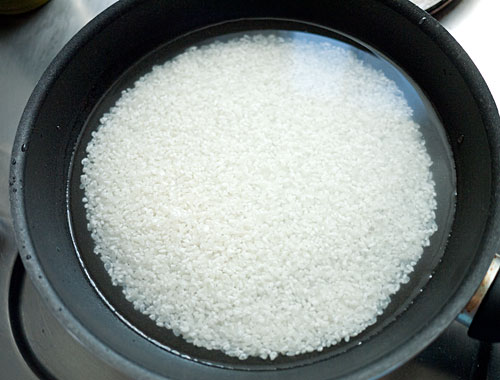
Put the frying pan on the stovetop over high heat with the lid on. Bring to a boil - the water will bubble aggressively, like so.
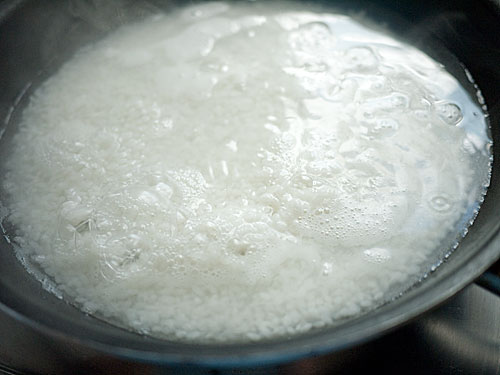
Give the rice a good stir up from the bottom with a spoon or spatula.
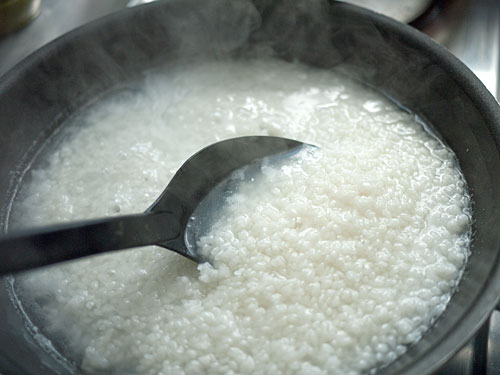
Replace the lid tightly. Lower the heat immediately to low.
If you're using an electric range, the heat will not respond instantly so you'll have high heat for a couple of minutes. Take the frying pan off the hot burner for a couple of minutes until the burner has had a chance to cool down to the low level.
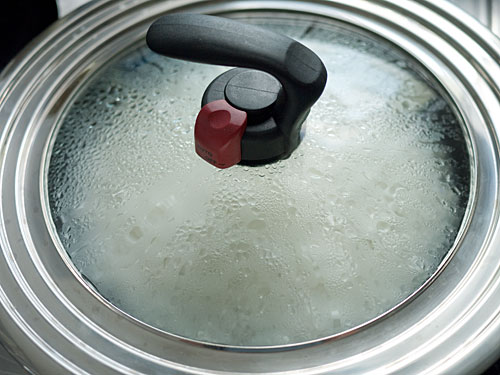
Let the rice cook on the low setting. You'll see the water get absorbed rapidly and big, starchy bubbles on the surface. This only takes about 5 minutes so be sure you're hovering near the pan with an eye on it! (I do other dinner-prep stuff while the rice is steaming.)

Once the bubbles have subsided, you'll see the surface of the rice with nice, even steam holes all over it. As soon this happens, turn the heat up to high for a minute or two, then turn the heat off. If you're using an electric range, take the pan off the hot burner and put it somewhere else (like on top of an unused burner).
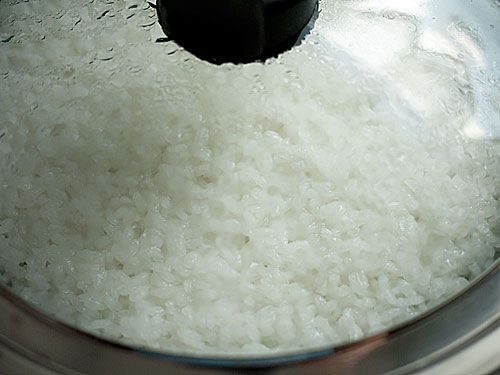
Let the pan rest with the lid on for a minimum of 10 minutes. This is very important, otherwise you may end up with a little hard center in your rice grains. Al dente is good for pasta, not for rice! (At least, it's not good for Japanese style rice. Other rices, I don't think so either.)
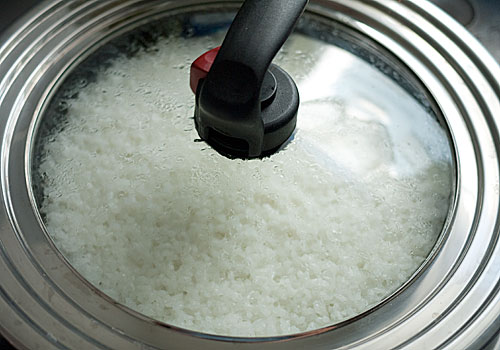
And...here's the cooked rice. Looks beautiful, doesn't it?
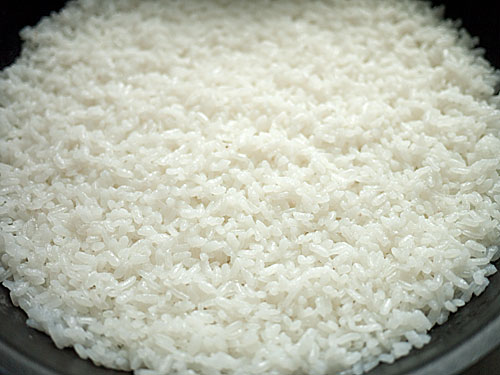
Here's the rice fluffed up. Perfectly cooked and ready to eat as-is or turn into onigiri, sushi rice, or whatever your heart desires.
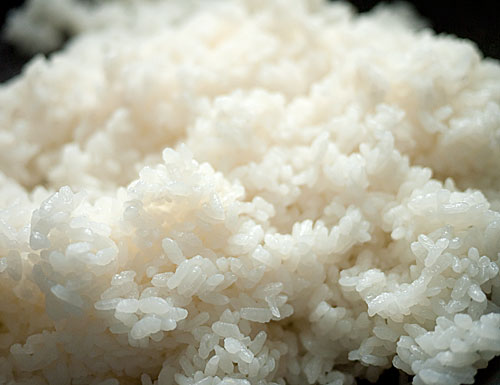
And...there are no burned bits stuck to the pan - I love easy cleanup! (Note: if you use a regular frying pan withint a non-stick surface, you may get some stuck-on bits. Also, if the final burst of high heat is too long, the bottom of the rice may get a bit brown.)
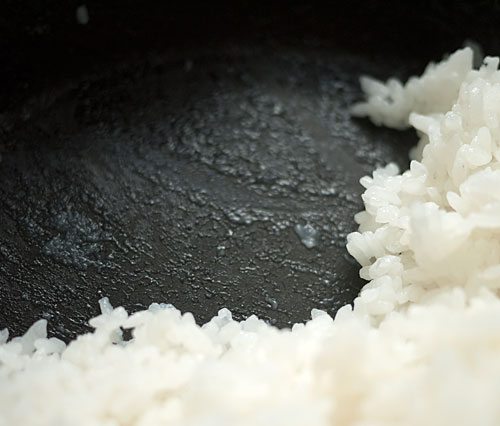
I had some of this batch as tamago kake gohan, raw egg and soy sauce on hot rice - one of my favorite breakfasts or snacks. (Not recommended unless you have really fresh, safe eggs.)
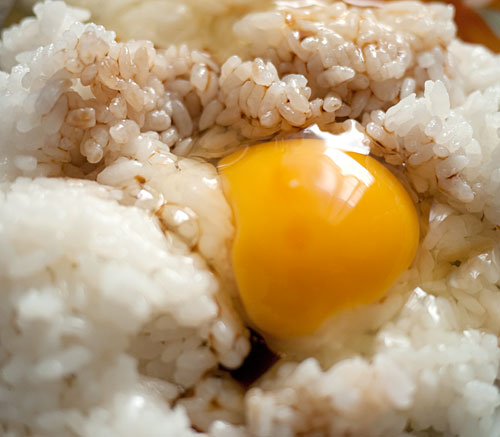
To sum up
Why does this work? According to that Passion Stadium broadcast it's because in a frying pan, the rice is spread out thinly on a large cooking surface, so it cooks fast and evenly. (That's why you shouldn't cook more than 2 cups (US cup measure, where 1 cup is about 240ml) of rice at a time in a 10-12 inch (26-30 cm) frying pan. If you're doing a large amount of rice, I'd recommend two frying pans going at once!
The tight fitting lid is very important, otherwise too much steam will escape during the cooking process. The one I use is a model that fits pans of various sizes, and is really handy.
I think this method is preferable to cooking rice in the oven. It's just as foolproof, much faster (you can have the rice all cooked in the time it takes to heat up a big oven) and far more energy efficient. And I like it better than microwave-cooking rice too, because I find having open take the bowl out of the microwave and stirring, etc. to be too cumbersome. To avoid all that taking out and stirring you need a special microwave-rice-cooking bowl, and this is all about not having to get special equipment to cook rice.
My rice cooker is still my everyday rice cooking device, since you can't beat its hands-off reliability and delayed-cooking-with-timer capability, not to mention the keep-warm feature. But if you don't have a rice cooker, and don't want to get one for whatever reason, or you're in a hurry to get some rice cooked in the shortest amount of time, I hope you'll give this a try!
(ETA: Yes, I do know what paella and risotto are. The texture of the rice in either dish is completely different from what I want Japanese style rice to turn out to be.)
If you enjoyed this article, please consider becoming my patron via Patreon. ^_^

 Welcome to Just Hungry, where we serve authentic Japanese recipes and more! I'm
Welcome to Just Hungry, where we serve authentic Japanese recipes and more! I'm 














Comments
Lauren W.
23 February, 2011 - 14:05
Permalink
Re: How to cook perfect rice - in a frying pan
This is a great article, sounds very easy. I, too, love and use my rice cooker frequently, but I can see this technique being really handy when visiting my rice cooker-less friends and family. I just can't seem to talk them into the purchase.
PS Can I move to the part of the US where electric ranges are uncommon? I know gas ranges are the de rigueur choice for fancy kitchen remodels now, but I've never had one. Nor has my mother, every time kitchens come up we sigh over our desire for fire. Maybe gas is more common on the coasts or something?
maki
23 February, 2011 - 15:14
Permalink
Re: How to cook perfect rice - in a frying pan
Hmm that's a good question. I've only lived in the NY-NJ area in the US, and there gas ranges are the norm. I guess you have to live somewhere with a natural gas supply...
bronwyncarlisle
23 February, 2011 - 22:43
Permalink
Re: How to cook perfect rice - in a frying pan
Really? Everyone has gas bottles for their outdoor grills don't they? That's what my gas range runs on. It has an electric oven and gas cooktop, and uses about one 9kg (~20lb) gas bottle every 6 months. So long as you can get gas bottles all you need is to find a shop that sells gas cookers and a plumber and electrician to install it.
maki
24 February, 2011 - 00:49
Permalink
Re: How to cook perfect rice - in a frying pan
Actually, in southern France (maybe the rest of France too but I haven't paid attention) that's how they do gas - with the bottles, which are sold at gas (petrol) stations. We still don't have a real kitchen and we're currently trying to decide whether to go with a gas, electric/IH or mixed range.
In Switzerland, you don't see gas bottles on sale at all. Everyone uses electric.
anon ^_^
24 February, 2011 - 04:47
Permalink
Re: How to cook perfect rice - in a frying pan
I agree with lauren-- I'd like to move to a part of the US where gas ranges are the norm! I've always thought/heard that electric was the norm in the US.
I don't think it's a coastal thing though, I grew up in NJ and moved to Atlanta, GA for school and I don't think I've ever known anyone who had a gas range. Maybe a couple people, but it was definitely less common than electric.
It's not just an issue of natural gas supply either, the last apartment I lived in had gas for heat but the stove was still electric.
TJ
17 March, 2011 - 03:53
Permalink
Re: How to cook perfect rice - in a frying pan
I don't know about other places, but definitely in the St. Louis, MO area gas stoves are EVERYWHERE. Hard to find a place with an electric stove, actually. I have no idea why.
Laura
24 February, 2011 - 00:19
Permalink
Re: How to cook perfect rice - in a frying pan
Yep, I live in Louisiana (hurricane risk!) and many houses have gas ranges and ovens. It's not just high-end houses either--our first apartment here had gas. It's great when the electricity is out. We managed 8 days without power during Hurricane Gustav with our sanity intact because we could cook!
LK
23 February, 2011 - 16:34
Permalink
Re: How to cook perfect rice - in a frying pan
THANK YOU FOR THIS!! I have been packing my rice cooker with me every time I go home for the holidays. (I'm in college, so that is often.) Never again!
The Robot Lunch Box
23 February, 2011 - 19:04
Permalink
Re: How to cook perfect rice - in a frying pan
Great article! I will definately try this when I next make a Katsu curry!
yoshi
23 February, 2011 - 19:51
Permalink
Re: How to cook perfect rice - in a frying pan
This is a great article. If you don't have a rice cooker, this is definitely the way to go. I'd like to add though, as one who's made rice the "old fashioned way" over a fire and a steel kettle, sometimes that burnt rice at the bottom of the pan is the best rice ever. But I know it's not for everyone. :D Awesome article! I'm gonna have to make it this way just so I know how to do it for sure when I'm rice cooker-less.
maki
23 February, 2011 - 21:59
Permalink
Re: How to cook perfect rice - in a frying pan
To get a crispy bottom, just increase the amount of time you give the rice a high-heat blast before turning off the heat for the final lid-on rest. Using a cast iron frying pan will help too. Added bonus: with a frying pan, you get a lot of crispy bottom. ^_^
anon.
23 February, 2011 - 21:52
Permalink
Re: How to cook perfect rice - in a frying pan
GOD! I love tamago kake gohan!!! It was my first breakfast in Japan at Sukiya.
the taste is just perfect! but most people here in germany disgust eating raw egg..
I'm getting appetit now... wwww
inktwig
24 February, 2011 - 04:40
Permalink
Re: How to cook perfect rice - in a frying pan
I miss being able to have a (safe) raw egg with my hot rice. I'm originally from the Philippines and we do that too -- raw egg with soy sauce for breakfast, and I use to have it with dried salted fish and some vinegar...
David Thompson
23 February, 2011 - 22:35
Permalink
Re: How to cook perfect rice - in a frying pan
I've been cooking rice in a frying pan for years when I camp out. It tends to work better in a pan than a pot when cooking over a Coleman stove. The method is essentially the same: pre-soak, cook, let the steam finish the rice while it rests. Maybe you should do an article on Bento-camping!
tudza
23 February, 2011 - 23:09
Permalink
Re: How to cook perfect rice - in a frying pan
To me this seems only a minor improvement in method since I used to make rice in a pot on the stove for years and years and years. These days I use the microwave, no stirring or special cooker, just 5 minutes on high and 15 minutes at half power in a bowl with a lid, done.
Now making rice in an oven, never tried that. I suppose if all I have is an oven and a pot with a lid, it would come down to that.
Much more likely to happen is I buy one of those weird metal canisters they use to cook rice over a camp fire.
Christine B
24 February, 2011 - 02:28
Permalink
Re: How to cook perfect rice - in a frying pan
Thank you for this post. I have found it difficult to make Japanese rice properly in the past and I love it so much! I prefer the texture and the taste over Thai Jasmine rice and basmati.. You also can't make yakimeshi without it!!
anon.
24 February, 2011 - 06:47
Permalink
Re: How to cook perfect rice - in a frying pan
I had to chuckle when I read this. This is how my family has made rice for decades, years before the rice cooker was invented! My parents probably grew up cooking it on gas stoves, but I grew up with electric ranges (in Louisiana!). We had it down to a fairly precise science where we brought the rice and water to a boil, then quickly cut the temperature to low heat (#2 on some ranges that have settings from 0 to 10) for 20 minutes, then very low (setting #1) for another 20 minutes. We moved to rice cookers because it was a pain to keep remembering to cut the temperature setting down, but not after spending a LOT of time convincing my mother that a rice cooker could make just as good rice, but more conveniently and in larger quantities. The other key is to make sure you never never lift the lid, or the steam will escape and the rice will not be soft. There was some Japanese poem my mother used to recite about never lifting the lid. Sometimes the brown crusty rice at the bottom (okoge, right?) was a treat to eat like a snack.
Anyway, I guess it is good to go back to the basics.
I really miss nama tamago gake gohan. I am dating myself, but there was a time when eggs in the US were safe to eat raw. Now I use grated nagaimo or a similar type of gooey root vegetable, which has a similar consistency as the raw egg.
Folly
24 February, 2011 - 17:37
Permalink
Re: How to cook perfect rice - in a frying pan
anon, you took me right back to my childhood with your description of your mother's cooking method. I remember that very precise order of clicks in my mother's kitchen! Except we had a gas stove and instead of numbers on the dial we used the face of the clock- 12 o'clock, 6 o'clock, 3 o'clock, off. We also had a big special pot to cook the rice. The top rim curved in to catch any bubbling over water. I didn't see that design again until I saw the rice chef on Cool Japan design the same curved rim on his ceramic rice pots.
anon.
25 March, 2011 - 05:40
Permalink
Re: How to cook perfect rice - in a frying pan
Hey, us, too! We had a special pot with curved sides to keep the water from spilling over. I thought it was just a salvaged pot from my grandfather's antique store, but maybe it was a dedicated rice pot?? I like how you used the clock numbers to gauge the temperatures.
Folly
24 February, 2011 - 08:31
Permalink
Re: How to cook perfect rice - in a frying pan
Great article. I am going to pass it along to some older Nisei friends who reminisce fondly about that crunchy bottom layer of rice from the pre-electric-rice-cooker days of their childhood.
Recently on "Cool Japan," a Japanese lifestyle program broadcast in English in the U.S., they explored a Kyoto restaurant, Sojiki Nakahigashi, that features rice three ways. The first is the freshly steamed rice before mixing. The second is the fully steamed and rested rice with a meal. And the crowning glory is the crunchy bottom layer. The restauranteur also had special pots and gas stovetop created to make perfect rice.
Folly
24 February, 2011 - 08:31
Permalink
Re: How to cook perfect rice - in a frying pan
Great article. I am going to pass it along to some older Nisei friends who reminisce fondly about that crunchy bottom layer of rice from the pre-electric-rice-cooker days of their childhood.
Recently on "Cool Japan," a Japanese lifestyle program broadcast in English in the U.S., they explored a Kyoto restaurant, Sojiki Nakahigashi, that features rice three ways. The first is the freshly steamed rice before mixing. The second is the fully steamed and rested rice with a meal. And the crowning glory is the crunchy bottom layer. The restauranteur also had special pots and gas stovetop created to make perfect rice.
Folly
24 February, 2011 - 08:39
Permalink
About that see-thru universal lid ..
Is that something I can find in the U.S? Or do I have to fly to France or Tokyo to find one? I would love to see what is going on when I am cooking.
maki
24 February, 2011 - 10:16
Permalink
Re: About that see-thru universal lid ..
It's just a generic lid that I got at Migros (Swiss supermarket chain)...but I have seen similar lids sold elsewhere though!
maki
24 February, 2011 - 10:20
Permalink
Re: How to cook perfect rice - in a frying pan
I should mention that that Passion Stadium program also featured other ways of cooking rice. The base comparison point was rice made in a regular old rice cooker. They also tried an enameled cast iron pot (a Le Creuset type), a traditional cast iron pot (tetsugama), a ceramic pot (donabe) and a ceramic pot specially designed for making rice. Each method had its good points, all were deemed to produce better tasting rice than the rice cooker. I picked up on the frying pan one since it requires no special equipment. ^_^
anon
8 July, 2011 - 07:19
Permalink
Re: How to cook perfect rice - in a frying pan
Did they say which method produced the best tasting rice? Or were they all about the same/all equally better than rice cooker rice? I've been debating about getting a rice cooker but maybe I'll stick with one of these methods instead since I'm most interested in the tastiest rice ^_^ I'd be interested in hearing more about the pros/cons of the various methods(especially with regards to taste), I don't think my Japanese is good enough to poke around on their website and see if more info is there....
Suzanne
24 February, 2011 - 11:54
Permalink
Re: How to cook perfect rice - in a frying pan
Has anyone ever tried cooking rice in a "bed"? The method is like this: bring the rice and water to a boil, turn off the heat and put the pan in a bed/comforter/box with hay/wool or whatever... it should be ready in a couple of hours. I know it works with regular rice, but how would japanese rice keep?
Chris
24 February, 2011 - 12:13
Permalink
Re: How to cook perfect rice - in a frying pan
Maki,
Thank you for yet another useful recipe!
May I ask you what is the brand of your universal fit glass lid? (I didn't even know they existed... oops!)
Joana Cardoso
24 February, 2011 - 12:29
Permalink
Re: How to cook perfect rice - in a frying pan
This post brings back memories.I am spanish,and my husband japanese.11 years ago when we started dating he would come home and I would cook spanish food for him.It was no surprise for him to see spanish dishes as paella or arroz a banda cooked on a pan,but when he first saw me cooking white plain rice on a pan... :O he was so shocked!!hahaha I don't think he ever saw rice cooked other way than with a rice-cooker (actually when he first came to study in Spain,the very first item his mum brought for him was a rice-cooker)
Now,its me the one who always uses the rice-cooker,and it has become a must on every house we've moved to.
Darlene
24 February, 2011 - 15:40
Permalink
Re: How to cook perfect rice - in a frying pan
Yes very simple. I am of Mexican decent & this is the way we have been making rice....forever. Two years ago I bought a rice cooker because I wanted to start making sushi rice & just about every web recipe called for a rice cooker. I'm glad I have it...so easy to use. But when making long grain rice & basmati I go back to what I know 'using the cook top'. Thanks.
gaijinfarmer
26 February, 2011 - 11:56
Permalink
Re: How to cook perfect rice - in a frying pan
Interesting. I sometimes like to heat the rice in the frying pan before adding the water--the water comes to a boil nearly instantly and the rice soaks it up quickly.
For delicious brown rice, soak it overnight before you cook it. And if you have the time, soak it for 6 hours then rinse every 2-8 hours (depending on the season) for a day or two. If you have fresh brown rice, this should get you hatsuga-genmai, or sprouted brown rice. Easy, really delicious, especially as ume onigiri, and healthy!
-gaijinfarmer
Panel çit
26 February, 2011 - 21:36
Permalink
Re: How to cook perfect rice - in a frying pan
I miss being able to have a (safe) raw egg with my hot rice.
mac
28 February, 2011 - 04:08
Permalink
Re: How to cook perfect rice - in a frying pan
I was wondering... It's late at night here and I want to soak the rice now. Could I leave it soaking over night?
maki
1 March, 2011 - 00:01
Permalink
Re: How to cook perfect rice - in a frying pan
Sure - that should work fine! Lots of people rinse their rice before going to bed to cook (or finish cooking in a rice cooker) in the morning.
Ashley
28 February, 2011 - 18:24
Permalink
Re: How to cook perfect rice - in a frying pan
I would have to say that in my experience, at least in the Midwest (Kansas) where I live, almost no one has a gas stove; unless they live in a really old house which has a gas-line to the kitchen (my old Victorian apartment in college was like this), or they are well-to-do.
nabi
3 March, 2011 - 05:38
Permalink
Re: How to cook perfect rice - in a frying pan
TKG : breakfast of japanese champions. or maybe charlatans.. i forget, but i'm sure it's breakfast.
Gregg
12 March, 2011 - 09:41
Permalink
Re: How to cook perfect rice - in a frying pan
I will have to give this a try. I miss making rice the old fashioned way.
I read about a Louisiana way to cook rice. Just pretend it is pasta. Put it in a big pot of water and boil until done. Drain and serve.
Works well with U.S. long grain rice. Wonder how it would be with Japanese rice? I would think the starch would be too much. Time to experiment!
Ena
7 November, 2012 - 21:39
Permalink
Boiling rice in a pot full of water
My Mum always cooked rice like that - like pasta. Its a really common way to cook rice in Australia if you aren't asian! She is generally a fantastic cook but I can't really recommend rice that way, the grains get waterlogged, sort of exploded and soggy. Although you can make it into good fried rice if you lay the cooked rice in a tray in the fridge overnight to dry out. This is using regular long grain rice of course, I don't think you could get anything else in Australia until about 20 years ago...
anon.
30 March, 2011 - 01:05
Permalink
Re: How to cook perfect rice - in a frying pan
I'm here living in a hostel in Japan whilst I study Japanese and the rice cooker here is absolutly rooted. So I've been trying to find a way to cook perfect rice without using the cooker. Thankfully I have found one.
Lori
14 April, 2011 - 05:25
Permalink
Re: How to cook perfect rice - in a frying pan
I tried twice and it stays slimy without all the water/slime water boiling out. I done everything, and closely watched it and read and re-read he instructions on the bag. The slime doesnt go away T_T is there anything I'm doing wrong? And I have even added less water the second time.
(Sorry if I posted this twice in two different places, I missed and typed it the wrong page]
maki
14 April, 2011 - 07:20
Permalink
Re: How to cook perfect rice - in a frying pan
Don't follow the instructions on the bag for the amount of water. I think they usually list too much. Try for a 1:1 ratio of water vs. rice or 1:1.1 (so, for every cup of rice, 1 cup and a bit of water) and see how that goes.
MissSky
5 June, 2011 - 20:43
Permalink
Re: How to cook perfect rice - in a frying pan
I've always cooked rice like this, but in a pot.
love rice
24 June, 2011 - 07:55
Permalink
TIPS!!!
sounds great!!! a few tips: When stirring rice use a fork. The grains turn out more fluffy that way.
as u r steaming the rice sprinkle salt on the top (a little) this makes for som added flavor (if making rice balls and what not skip the salt)
if u soak the rice first watch carfully to avoid over cooking.
this is a great way to cook rice i love the results!!! thanks. oh and whats really good is adding some fried egg to the cooked rice. yum!
maki
27 June, 2011 - 22:44
Permalink
Re: TIPS!!!
"Fluffy" is not applicable to properly cooked Japanese style rice.
mirjam
27 July, 2011 - 15:43
Permalink
Re: How to cook perfect rice - in a frying pan
I don't own a ricecooker, so I usually cook my rice in the oven: boil 225 ml water, drop in 150 gr rice (or any 3:2 ratio), put a lid on it and put it in a warm (180Celsius) oven for 16 minutes. Remove from oven and wait another 10 minutes, and most of the times my rice is pretty perfect.
sossowonder
4 November, 2011 - 12:11
Permalink
at last !
thank you very much for this recipe ,
I ‘ve been looking around for a rice recipe that would be as good as at my favourite japanese restaurant ,
i’m gone try this one right away !
Whenever you want to watch porno gratuit, go and visit this amazing website !
Nik
14 February, 2012 - 20:40
Permalink
Re: How to cook perfect rice - in a frying pan
I've been looking for a way to cook a single serving of rice fooorrrevverrr. Thank you!
To make a single serving of rice I use the same steps you've laid out, using 1/2 c drained rice and a 7 inch saucepan.
I think the key is making sure that the layer of rice on the bottom of the pan isn't more than 1/2'' thick.
LittleJapanMama
16 June, 2012 - 15:42
Permalink
Thanks Maki, for this innovative tip!
I grew up in Australia, and my mother migrated from Japan before rice cookers became common (a LONG time ago), so it was normal for us to make rice in a saucepan. I have never imagined that it was possible in a frypan, in fact it looks awesome! Thanks Maki, for this innovative tip!
Jenny
16 June, 2013 - 12:07
Permalink
Re: How to cook perfect rice - in a frying pan
Ahh, thank you! We are living in Japan for the summer and i couldn't pack my rice cooker. Just followed the steps above and had absolutely beautiful rice. WIll be using this method often! Thanks again!
charlie
3 August, 2015 - 17:27
Permalink
Cooking rice that is not sticky
Yes, I have been cooking rice in a frying pan for years. Same method as above. The only other thing that you do: boil the rice for 4-5 minutes. Then rinse the rice a few times till it is clear. this step removes the extra starch (good for diabetics) that makes the rice sticky. Then you put it back in the pan and add hot water to cover the rice. Put a tight fitting lid on. Let it boil. Then you turn down the heat to lowest setting (on mine #1). After 15-20 minutes, you have rice that is not sticky. You can even make fried rice right away without cooling it off. One other thing to mention: if you put the rice in the fridge for about 12 hours, then reheat it, the starch becomes "resistant starch (google this)" and reduces the calories by about half.
Diane Lee
20 September, 2015 - 00:57
Permalink
How to make rice in a frying pan
I've made this several times and it has come out perfect every time !! Thank you so much !!! I love making rice now !!!